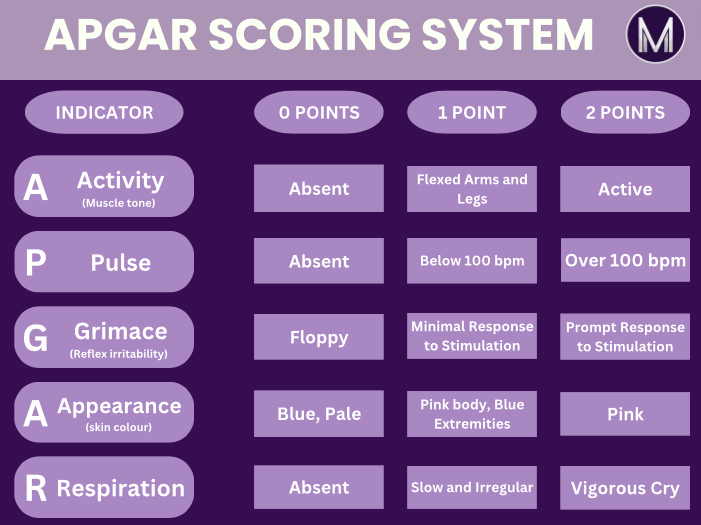
Your Guide to APGAR on the NCLEX
Have you ever wondered how nurses and doctors quickly check a newborn’s health right after birth? That’s the magic of APGAR, a fast tool we’ll unravel for your NCLEX journey.
Overcoming APGAR NCLEX questions may seem tricky, but worry not. This guide is your helper. We’ll make NCLEX APGAR questions easy, turning stress into success on your NCLEX adventure.
What is APGAR?
APGAR, acronym for Appearance, Pulse, Grimace response, Activity, and Respiration, is a rapid assessment tool designed to evaluate the immediate well-being of a newborn. Each component is scored on a scale of 0 to 2, with 2 being the highest, resulting in a total score ranging from 0 to 10.
1. Appearance:
This component assesses the newborn’s skin color. A score of 2 indicates a healthy pink color, while lower scores may indicate varying degrees of pallor or cyanosis.
2. Pulse:
The pulse evaluation gauges the newborn’s heart rate. A score of 2 is assigned for a heart rate over 100 beats per minute, while lower scores indicate a slower heart rate.

3. Grimace response:
Also known as reflexes, this component tests the newborn’s reflexes and response to stimuli. A score of 2 suggests a vigorous response, while lower scores indicate a diminished or absent reflex response.
4. Activity:
The activity component assesses the newborn’s muscle tone. A score of 2 is given for active movement and resistance to extension, while lower scores suggest varying degrees of muscle tone and activity.
5. Respiration:
Respiration evaluates the newborn’s breathing effort. A score of 2 is assigned for vigorous crying, indicating a strong respiratory effort. Lower scores may suggest weak or irregular breathing patterns.
In summary, the APGAR score provide a comprehensive snapshot of a newborn’s immediate health, encompassing vital aspects like color, heart rate, reflexes, muscle tone, and respiratory effort. Understanding these components is fundamental not only for healthcare professionals but also for those preparing for the AGPAR score NCLEX questions on the exam, where questions related to APGAR scores often play a significant role.
How Important is Mastering APGAR for NCLEX?
Proficiency in APGAR is paramount for success in the NCLEX, with questions on neonatal assessments frequently featured in the pediatric nursing section. Mastery in APGAR NCLEX questions is not only an exam requirement but also directly applicable in real-world healthcare scenarios, making it an essential skill for nursing practice.
Beyond exam settings, a strong grasp of APGAR is crucial for effective clinical practice. Nurses equipped with APGAR mastery can contribute meaningfully to neonatal care, ensuring prompt and accurate assessments in real-world healthcare scenarios.
Recognizing the importance of APGAR score NCLEX questions not only ensures success in the NCLEX but also prepares you for the challenges of neonatal care in real-world nursing practice. The next section will address common challenges in APGAR score NCLEX questions, offering practical tips for overcoming them.
Practice APGAR NCLEX Questions
Question 1:
A newborn has pink skin, a heart rate of 120 beats per minute, grimaces when stimulated, actively moves its extremities, and has a strong cry. What is the APGAR score at 1 minute?
a. 5
b. 7
c. 8
d. 10
Question 2:
A newborn exhibits central cyanosis, a heart rate of 80 beats per minute, weak grimace response, minimal muscle tone, and irregular respiratory efforts. What is the APGAR score at 5 minutes?
a. 2
b. 4
c. 6
d. 8
Question 3:
During APGAR assessment, the baby cries when stimulated, flexes its arms and legs actively, has a heart rate over 100 beats per minute, pink hands and feet, but exhibits mild central cyanosis. What is the appropriate action based on this assessment?
a. Administer oxygen immediately.
b. Observe the baby closely for any signs of distress.
c. Perform resuscitation measures.
d. Request a pediatric consult.
Question 4:
A newborn presents with a heart rate of 60 beats per minute, absent grimace response, floppy muscle tone, and irregular respirations. What immediate interventions should the nurse prioritize based on this APGAR assessment?
a. Begin chest compressions.
b. Administer oxygen via mask.
c. Stimulate the baby further to assess responsiveness.
d. Initiate positive-pressure ventilation.
Question 5:
A preterm newborn exhibits acrocyanosis, a heart rate of 160 beats per minute, a vigorous cry, actively moves its extremities, and displays good muscle tone. What considerations should the nurse keep in mind when interpreting this APGAR score?
a. Consider the impact of prematurity on APGAR scoring.
b. Administer surfactant immediately.
c. Prepare for emergency resuscitation.
d. Document the findings as normal for a preterm infant.
Test Day Tips for APGAR-related NCLEX Questions
Embarking on your NCLEX journey involves not just knowledge but also effective strategies for navigating APGAR-related questions. Here are five essential tips to boost your confidence on exam day:
1. Time Management is Key:
Allocate a specific amount of time for each APGAR-related question. Avoid spending too much time on a single question, ensuring you have ample time for the entire section.
2. Trust Your Instincts:
If you encounter a challenging question, trust your initial instincts. Your first response is often the most accurate, and overthinking can lead to second-guessing.
3. Flag and Prioritize:
If uncertain about an answer, use the flagging feature to revisit it later. Prioritize questions based on your confidence level, answering the ones you find most straightforward first.
4. Stay Calm Under Pressure:
Maintain composure during the exam. Take deep breaths, focus on the question at hand, and avoid letting stress impact your concentration.
5. Review Sparingly:
While reviewing flagged questions is essential, avoid making extensive changes unless you’re certain of an error. Trust the preparation you’ve put in leading up to the exam.
These test day tips are tailored to enhance your performance specifically on APGAR-related questions. Remember, confidence is key, and a calm, focused approach will contribute to your success on the NCLEX exam. Best of luck!
Conclusion
Mastering APGAR for the NCLEX involves confident navigation of neonatal assessments. We’ve covered its importance, offered practice questions, and provided strategies for exam success.
As you journey through this preparation, remember APGAR is more than an acronym—it’s a roadmap to understanding newborn health. Diligent practice, strategic preparation, and test-day tips prepare you for success in the NCLEX pediatric nursing section. To boost your revision, you can find NCLEX practice questions free online.
For personalized guidance, connect with experienced NCLEX tutors from Medic Mind. Specializing in challenging topics like APGAR, they prioritize your success. Your journey to becoming a nurse starts with the right support.
FAQs
Why is the APGAR score important for nursing students preparing for the NCLEX?
The APGAR score is a fundamental aspect of neonatal assessment, often tested in the pediatric nursing section of the NCLEX. Nursing students need to master APGAR as it plays a crucial role in evaluating the immediate health of newborns, preparing them to handle related questions confidently during the exam.
How can I effectively differentiate between the various components of the APGAR score?
To differentiate between APGAR components, focus on understanding the specific indicators for each: Appearance, Pulse, Grimace response, Activity, and Respiration. Engage in practical scenarios, use flashcards, and create personalized mnemonics to reinforce your ability to distinguish and interpret each component accurately.
Are there any common misconceptions about APGAR scores that I should be aware of for the NCLEX?
Yes, a common misconception is that a high APGAR score guarantees perfect health. It’s crucial to understand that while a high score is generally positive, some conditions may not be immediately apparent. Familiarizing yourself with such misconceptions ensures you approach APGAR-related questions on the NCLEX with a nuanced perspective.
Should I prioritize answering APGAR NCLEX questions in a specific order during the NCLEX exam?
Prioritizing APGAR questions can enhance your efficiency. Start by addressing questions that seem more straightforward to you, and then revisit those you find challenging. Effective time management ensures you can answer all questions within the allocated time frame, improving your overall performance on the exam.
Can I expect questions related to premature infants and their APGAR scores in the NCLEX exam?
Yes, questions related to premature infants and APGAR score NCLEX questions are common. Understanding the impact of prematurity on APGAR scoring is crucial. Consider the specific challenges and variations that may arise in assessing APGAR scores for preterm newborns.





Was this article helpful?
Still got a question? Leave a comment